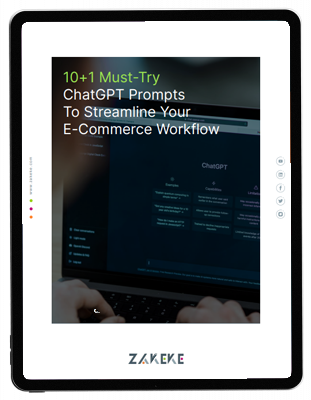Ever wondered what sets the e-commerce giants apart from the struggling contenders? In the world of online shopping, where choices are endless, and attention spans are fleeting, it all boils down to one vital factor: crafting seamless e-commerce customer journeys.
Did you know that nearly three-quarters of consumers believe their experience’s quality is crucial to their loyalty to the brand? Yes, you heard that right — 73% of consumers swear by the influence of a good experience regarding their brand loyalties. Brands that excel in customer experience are reaping the rewards beyond measure. They’re not just staying ahead of the competition but leaving them in the dust, bringing in 5.7 times more revenue than those who falter in the customer experience race.
In this fast-paced e-commerce universe, from the moment your potential customers click on your site, you hold the power to influence their perceptions and decisions.
What e-commerce sellers should know about the customer journey? Get ready because we’re about to navigate the winding roads of e-commerce success, where seamless customer journeys reign supreme.
Understanding the Importance of Customer Journeys
Understanding customer journeys is vital in today’s business landscape. These digital pathways not only wield influence over brand loyalty but also act as drivers for revenue growth.
Recognizing the Significance of E-Commerce Customer Journeys
Customer Journey is a digital pathway that defines how customers interact with your brand, from the initial click to the final purchase. Every step from browsing to checkout is a crucial touchpoint that can make or break a sale. The importance of these journeys lies in their power to shape brand perceptions, drive conversions, and foster customer loyalty.
By recognizing and optimizing e-commerce customer journeys, e-businesses can thrive in a competitive marketplace, building sales and lasting relationships with valued customers.
E-Commerce Customer Journey Map: Key Concepts and Benefits
Understanding and mapping the customer journey is a strategic imperative for e-commerce success. It’s like having a treasure map that leads to increased sales and customer satisfaction. So, what’s the map’s key? It’s all about knowing your customers’ touchpoints and preferences as they navigate your online store.
Here are some key benefits of understanding and mapping e-commerce customer journeys:
- Improved Customer Experience: Enhancing the shopping experience makes satisfied customers more likely to return.
- Higher Conversions: Identifying and addressing pain points can increase conversion rates and increase sales.
- Increased Brand Loyalty: A seamless journey builds trust and loyalty, turning one-time shoppers into repeat customers.
- Revenue Growth: A well-mapped customer journey can result in higher revenue as more satisfied customers purchase and recommend your brand.
Research and Customer Insights
Understanding your audience is the core of an effective e-commerce strategy. Research and customer insights pave the path to success, offering a deep dive into shopper behaviors, preferences, and personas. Let’s delve into the art of gathering, analyzing, and utilizing these invaluable data points for strategic, targeted approaches.
Gathering Comprehensive Customer Data
In e-commerce, knowledge is power and that knowledge starts with gathering comprehensive customer data. It’s like putting together the puzzle pieces, helping you understand your audience deeply. Customer data encompasses various aspects, from demographics to online behavior.
To gather this treasure of information, you can employ tools like surveys, analytics, and even social media insights. These methods help you find who your customers are, what they like, and how they engage with your brand.
Analyzing Customer Behavior and Preferences
For every e-commerce business owner, understanding customers’ behavior and preferences is like having a roadmap to success. It’s all about observing how they interact with your website, what products they love, and what keeps them engaged. This data isn’t just numbers; it’s the key to tailoring your offerings to their desires.
You can identify trends and patterns that reveal valuable insights by carefully examining the data gathered. You can discover which products are hot sellers and the times of day when customers are mostly active, etc. It’s the secret that keeps your e-commerce business ahead of the curve.
Creating Customer Personas for Targeted Approaches
Crafting customer personas is a game-changer in the realm of e-commerce. Think of them as detailed character sketches of your ideal customers. These personas are crafted from the data you’ve gathered, allowing you to understand your customers on a personal level.
By creating these personas, you can visualize your customers’ needs, preferences, and pain points. This insight guides you in tailoring your marketing, product offerings, and customer interactions to align perfectly with what your customers want. It’s like having a personalized approach for each segment of your audience, ensuring that your e-commerce strategies hit the mark and resonate deeply with the people you aim to serve.
Optimizing User Experience (UX)
In the e-commerce landscape, the key to winning over customers lies in perfecting their experience. Enhancing user experience (UX) is a way that transforms casual visitors into loyal shoppers. Let’s delve into designing intuitive websites, improving navigation, and boosting performance for a seamless journey.
Designing Intuitive and Mobile-Friendly Websites
Your website is your storefront and it should be user-friendly. Simplicity should be the key while designing an e-commerce platform. An intuitive interface guides users effortlessly, ensuring they can find what they need without frustration.
Moreover, in this era, a mobile-friendly website is a must for any brand. Your website should adapt seamlessly to various screen sizes like smartphones or laptops, providing the same excellent experience. These design principles enhance user satisfaction and boost conversion rates, making your e-commerce venture a more inviting and profitable destination for shoppers.
Streamlining Navigation and Search Functionality
The key to navigation in an e-commerce store is to ensure that visitors can effortlessly find what they’re looking for. You need to organize your site logically, with clear menus and categories. This ensures that customers can browse and discover products without getting lost in a digital maze.
Additionally, search functionality plays a vital role. A robust search feature allows users to enter keywords and quickly pinpoint items of interest. By optimizing these aspects of your website, you create a hassle-free shopping experience that keeps customers engaged and satisfied, ultimately leading to higher conversions and success in the e-commerce arena.
Enhancing Website Speed and Performance
To sell online, speed is your secret weapon. Customers want websites that load quickly, and if they encounter delays, they may leave before making a purchase. Enhancing website speed and performance involves optimizing various elements, from image sizes to server response times. A swift-loading site keeps shoppers engaged and boosts your search engine rankings, leading to more visibility and traffic.
An optimized website isn’t just about speed; it’s also about reliability. You must ensure your site runs 24/7 to build trust with the audience. Investing in these features can help you create a seamless e-commerce experience that can drive customer satisfaction.
Personalization and Customization
In the online world, customization is the key to capturing your customers’ hearts and wallets. E-commerce managers need to know the art of tailoring product recommendations and how to leverage personalized email marketing to create memorable and engaging shopping experiences.
Tailoring Product Recommendations
Product recommendations are like having a personal shopping assistant for each customer. It’s about using data and insights to suggest items that match their preferences and past purchases. This approach enhances the shopping experience and increases the chances of conversions.
By analyzing customer behavior and understanding their interests, you can present them with options they’re more likely to buy, making their journey on your website more engaging and enjoyable. These personalized recommendations can boost sales and cultivate loyalty, creating a win-win situation for both your e-commerce business and your valued customers.
Implementing Dynamic Content
Your e-commerce website should adapt and respond to each visitor’s unique needs and preferences. This is the benefit of implementing dynamic content. Instead of showing a one-size-fits-all webpage, dynamic content tailors what each visitor sees based on factors like their location, browsing history, or even the time of day.
This personalization makes the shopping experience more relevant and engaging. For example, a visitor from a sunny location might see summer attire, while someone from a colder climate sees winter options.
Offer Product Personalization
Customers are increasingly seeking personalized experiences throughout their shopping journeys. What could be better than offering a fully customized experience, allowing customers to create their dream product with texts, colors, and elements of their choice?
If you’re wondering where to start, it’s simple! Integrating a Product Customizer, just like Zakeke, into your store is a breeze. Zakeke provides a Plug&Play integration, and in just a few seconds, it enables you to offer customizable products directly on your e-commerce platform.
Seamless Multichannel Integration
In e-commerce, bridging the online and offline worlds is crucial to success. Let’s explore how coordinating social media, website, and in-store experiences creates a seamless journey connecting with customers on all fronts.
Bridging the Gap Between Online and Offline Shopping
Customers often research online before visiting a store or vice versa, so blending the digital and physical shopping worlds is crucial. Bridging this gap means providing a consistent experience, whether they’re browsing your website or strolling through your store.
This integration allows customers to move effortlessly between online and offline channels, such as ordering online and picking up in-store. By harmonizing these experiences, you enhance customer convenience and create a unified brand identity, increasing the chances of conversions and loyalty in both the online and offline realms.
Coordinating Social Media, Website, and In-Store Experiences
The real magic of successful e-commerce lies in the art of coordination. Connecting your social media presence, website, and in-store experiences creates a symphony that resonates with customers. It’s about providing a consistent brand experience, no matter where customers interact with your product.
It’s like whenever customers see a product on any website, they want to engage with it on social media before buying it. This coordination not only boosts customer satisfaction but also reinforces brand loyalty.
Efficient Checkout Processes
The checkout process is where shoppers become buyers. There are strategies for simplifying the checkout process to ensure a smooth and successful transaction for your customers.
Simplifying the Checkout Process
Simplifying the checkout process makes the e-commerce customer’s journey from cart to purchase effortless. A streamlined checkout experience can significantly reduce cart abandonment rates, as shoppers are more likely to complete their purchase when the process is quick and straightforward. By simplifying the checkout, you can enhance customer satisfaction to improve your conversion rates, boosting your e-commerce success.
Offering Multiple Payment Options
In the diverse world of e-commerce, flexibility in payment is the name of the game. By offering multiple payment options, you cater to the varied preferences of your customers. Whether they prefer credit cards, digital wallets, or even buy-now-pay-later services, giving them choices ensures a more convenient and comfortable checkout experience.
This reduces the chances of cart abandonment and broadens your customer base by accommodating shoppers who may have otherwise left due to limited payment options.
Reducing Cart Abandonment Rates
Cart abandonment is a common challenge in e-commerce but also an opportunity for improvement. When customers add items to their cart but don’t complete the purchase, it’s like a story left unfinished. The key to reducing cart abandonment rates is to identify and address the reasons behind it.
Streamlining the checkout process, offering various payment options, and ensuring transparency in pricing and shipping costs are effective strategies, especially if you offer your own service like a coach, consultant, or freelancer. Additionally, sending follow-up emails or reminders can gently nudge customers to return and complete their purchases. By taking these steps, you recover potentially lost sales and provide a smoother and more satisfying shopping experience, enhancing your e-commerce success.
Customer Support and Communication
Customer support plays a pivotal role in retaining customers and fostering lasting relationships. It includes real-time support, harnessing the power of chatbots and AI for seamless assistance and building trust. These elements are the key to keeping your customers coming back for more, ensuring your e-commerce venture’s success.
To elevate your e-commerce venture’s success, integrating the best AI chatbot for business into your customer support strategy is essential. By harnessing real-time support and leveraging the power of advanced chatbot technology, you not only provide seamless assistance but also build trust, fostering lasting relationships that keep customers coming back for more.
Providing Real-Time Support Options
Real-time support is like having a trusted friend right there with you. It’s about being available to your customers exactly when they need assistance. Whether through live chat, instant messaging, or a brief phone call — whatever method they prefer.
Real-time support options ensure customers can reach out with questions, concerns, or issues and receive immediate assistance. This not only solves problems promptly but also shows that you’re genuinely dedicated to their satisfaction. It’s vital in building trust and loyalty, making customers feel valued and more likely to return for future purchases.
Leveraging Chatbots and AI for Customer Assistance
Chatbots and AI are like reliable assistants, always ready to lend a helping hand. These smart tools can handle routine customer inquiries, provide product information, and even assist with checkout, all in real time. They work tirelessly, 24/7, offering instant responses and freeing up human support agents for more complex tasks.
The beauty of chatbots and AI lies in their efficiency and availability. Customers can get answers to their questions anytime, enhancing their overall experience. While they may not replace the human touch entirely, they certainly complement it by providing prompt assistance and contributing to seamless customer support.
Building Trust Through Transparent Communication
Transparent communication is the key to both establishing and preserving trust with your customers. It’s all about being straightforward with your customers, from providing accurate product descriptions to setting clear expectations for shipping timelines.
You must communicate honestly to help customers feel assured in their buying choices. This enhances their shopping experience and trust in your brand. In e-commerce, where transactions happen virtually, transparent communication becomes the bridge to building lasting trust and loyal customer relationships.
Continuous Testing and Improvement
In any business, success hinges on the commitment to ongoing testing and improvement. Let’s discuss how you can test your product and adapt to your valued customers’ ever-changing needs.
Conducting A/B Testing
A/B testing is crucial for optimizing your website and elevating the customer experience. This sophisticated process involves comparing web page versions by labeling them A and B. The primary objective is to pinpoint which version outshines the other when it comes to conversions, engagement, or the attainment of specific goals.
This testing involves refining various elements, such as headlines, images, and all-important call-to-action buttons. But here’s the kicker — it’s not just about making changes and crossing your fingers. A/B testing operates on a solid foundation of data-driven decisions. It’s akin to having a crystal ball that reveals precisely how your e-commerce site can evolve to meet the ever-evolving preferences and demands of your cherished customers.
Gathering and Analyzing Feedback
Gathering feedback through surveys, reviews, and customer interactions is like peering into customer thoughts. But collecting feedback is only the beginning. The real magic happens when you analyze this treasure trove of information. It helps you identify pain points and improve your products and services. It’s a way to build stronger, more meaningful relationships with your customers by showing them you’re dedicated to meeting their needs and making their journey smoother.
Iterating and Adapting to Changing Customer Needs
Customers always need brands to evolve over time. Your ability to iterate and adapt is the compass that guides your success. By embracing change, you keep your finger on the pulse of shifting customer preferences and market trends. It’s a journey of continuous improvement, where you listen to your customers, gather insights, and make strategic adjustments to your offerings. Whether it’s tweaking product features or enhancing website functionality, this adaptability ensures you remain not just a contender but a frontrunner in the ever-evolving world of e-commerce.
Conclusion
In the ever-evolving world of e-commerce, crafting seamless customer journeys is the foundation of success. E-commerce customer journey mapping, backed by comprehensive research and insights, leads to optimized user experiences and personalization. Integrating online and offline shopping, efficient checkout processes, and transparent communication foster trust.
Crucially, the journey never ends; it evolves. Continuous testing, feedback analysis, and adaptation ensure we remain agile, aligning our strategies with the ever-changing needs of our customers. These best practices aren’t just a formula for e-commerce success; they are the heartbeat of lasting customer relationships, propelling your business to new heights in the digital marketplace.
In this journey, where customers are at the center, excellence is not an option; it’s the only path forward.

Munim Ali
E-commerce Content Writer
Munim Ali is a highly skilled content writer with over 3 years of experience in the industry of Digital Marketing for e-commerce. With a proven track record of working with advertising agencies and organizations, he specializes in developing creative ideas and attainable solutions. He helps businesses tell their story and attract new customers.















